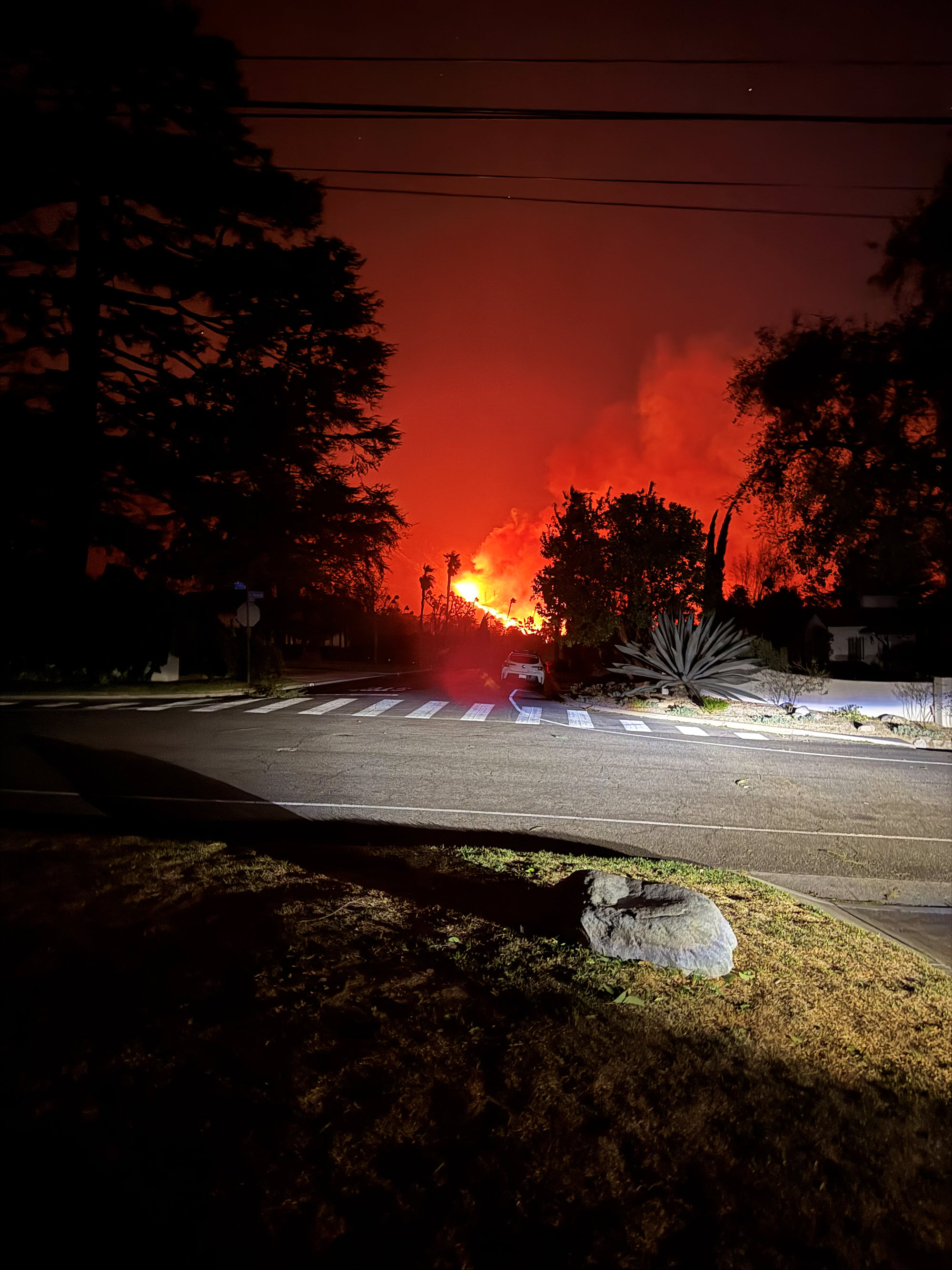It is the kind of destruction difficult to comprehend from afar, looking only at the pictures and videos.
Somehow, though, the devastation wrought this week by wildfires in Los Angeles County is only more mind-warpingly challenging to grasp for those people witnessing it first-hand – in real time, in their neighborhoods, in their front yards.
Four separate major wildfires raged across the second-biggest city in the United States last week. Perhaps as many as 40,000 acres of land burned; an estimated 10,000 structures and homes destroyed. And the fires aren’t out yet.
“In all my years leading emergency management operations in the county, I’ve never seen anything like this,” said Rossana D’Antonio, P.E., G.E., ENV SP, F.ASCE, an at-large director on ASCE’s Board of Direction with more than three decades of leadership experience with L.A. County Public Works.
“It is hard to wrap my head around the devastation, and the images take my breath away. I’m not sure L.A. will ever be the same again.”
Wind to ash
The week started with an ominous wind, whipping up last Sunday evening around Los Angeles County.
Ben Baker noticed it that night, hanging out with friends in Porter Ranch, northwest of downtown LA. “We could definitely sense that it was windy,” said Baker, P.E., M.ASCE, senior civil engineer for Gannett Fleming TranSystems and treasurer for the ASCE LA Metro Branch. “A ton of wind, but they just said it was kind of normal for up there. Still, it seemed like a lot of wind to me.”
By Monday night, those seemingly maybe-normal winds had grown to hurricane-force gusts.
A ways east from Porter Ranch, just north of Pasadena in the Altadena neighborhood, Isabella Salgado’s house was blasted by winds up to 100 miles per hour. They tore down the home’s front gate, damaged the backyard, and knocked out the power.
Salgado, A.M.ASCE, a civil engineer for the City of Los Angeles and secretary of the L.A. Younger Member Forum, remained at home that night despite the wind. She even woke up the next morning and went to work like any normal day. By the time she was driving back home after staying late in the office to finish up some work, it was clear that this was not a normal day.
“I was getting calls from my mom and my cousin, and they were just saying, ‘Get home immediately; there’s a fire and we’re evacuating,’” Salgado said.
“So then I pulled up to our house – and our house has a view of the Eaton Canyon – and I turned to my right and you could see the fire right there. It was just like, ‘Oh my goodness.’ It was just really scary. We’ve never experienced anything like this.”
Salgado’s family grabbed a few things very quickly, packed up the dog, and drove out of Altadena not knowing what was going to happen to their home. It was like a scene out of a movie, except that it was a reality playing out on hundreds of streets across the county.
“A year ago, there was some wet weather,” Baker said. “We had a lot of vegetation grow. But it’s been very dry lately, so all that dry vegetation is just tinder now.
“And those winds. They’ve really caused the fires to spread and made it very challenging for helicopters to drop water.”
 Isabella Salgado
Isabella Salgado
The new abnormal
What’s remarkable is just how much the threat of wildfire destruction has become integral to the California lifestyle.
Baker went to his father-in-law’s birthday party last Tuesday in Hastings Ranch, and, like Salgado, found the Eaton Fire forcing evacuations.
The family got out safely, and later Baker wanted to follow up on how the neighborhood was. Well, they have an app for that.
He simply tracked the Eaton blaze through his WatchDuty app on his phone.
“I have heard some people call wildfires a season now, as they would call mudslides or earthquakes another season in California,” Baker said. “We just need to be prepared and adapt to circumstances.”
Elsewhere, “go bags” are an accepted part of the new normal. Have what you need ready for whenever you may need it.
D’Antonio’s home in West Malibu was OK as of Friday, but she knew to be ready for whatever might be coming next.
“We are safe but still under evacuation warnings due to the Palisades Fire which continues to spread in the Malibu Hills,” D’Antonio said. “So, the ‘go bags’ are at the door. Power is out but we are blessed with a full house generator. Roads are closed and air quality is awful. We’ve had several sleepless nights but nothing compared to what some neighbors have experienced.”
Salgado didn’t have “go bags.” She and her mother only bought this house just last June. Salgado grew up in Fresno. She moved to L.A. three years ago and convinced her mom – also a civil engineer: Minerva Rodriguez, P.E., PMP, M.ASCE, the mentorship chair for the ASCE L.A. Metro Branch – to join her. They found a beautiful house in a beautiful neighborhood, close to work, close to nature. A wildfire sweeping down the hill onto their street on a Tuesday evening in January was not part of their calculus.
“I think we’ve learned a lot from this because we were not prepared at all,” Salgado said. “As soon as we saw the fire, we went frantic. We didn’t know what to pack. I literally barely packed any underwear; one set of PJs; like two sweaters, two pairs of pants. … and we just kind of took off with the shoes on her feet.
“As soon as we got out, all these things popped in our mind of things that we should’ve grabbed – important documents, birth certificates, passports. My mom has a lot of pictures of us that we wouldn't have been able to get back.”
Salgado, fortunately, had a chance to return to her home on subsequent days and loaded up more of her possessions, this time aided by the advice of someone with more wildfire experience.
“A friend had mentioned to me, ‘If you have the chance to go back, just take trash bags. Just dump as much as you can in the trash bags because you don’t have time,’” Salgado said.
Neighbors helping neighbors
There are silver linings in every tragedy. Or maybe not silver linings. But at least reminders of humanity’s power for good when called upon.
Salgado, her mother, and cousin stayed with family nearby the first night away from home. But, of course, the next day they desperately wanted to know if their house was still in tact.
It turns out some of their neighbors had been up through Tuesday night into Wednesday preemptively dousing their house with water and putting out smaller fires on the street.
When Salgado drove back that morning, she found that maybe two-thirds of the houses in her neighborhood were gone. Hers, though, was still standing.
“Those neighbors really protected our property, which we thank God for and we thank them,” Salgado said.
Salgado and her family then paid forward that grace.
They worked throughout Wednesday and Thursday on helping control fires in their neighborhood, first using water from garden hoses, and, then when the water was cut off, literally digging up yards and using the dirt to smother smaller fires.
“We actually put out a fire next to our neighbor’s home and saved their home from catching on fire,” Salgado said. “It’s incredible what the community can do when we come together.
“I think you head into survival mode. There’s no thought of ‘My life is in danger here.’ It’s just: ‘We need to help the community because they’ve been helping us.’ So you do what you can.”
Now what?
Civil engineers reckoning with wildfire damage bring a uniquely civil engineering perspective. Infrastructure means everything to people like Baker, D’Antonio, and Salgado. So it’s extra personal. But their background also means they have an all-too-painful understanding of just how long a road back this may be for the city they each call home.
“Me and my mom (who works at Parsons in Pasadena) have talked about it a lot,” Salgado said. “And my dad has done construction, and he came up and helped us a lot too, so we’ve been all talking about this. There is no way that you can get back to your home seeing what we’ve seen. The utility poles are on the ground. Live wires on the ground.
“It’s going to take a lot to rebuild.”
For now, fire personnel continue to fight the ongoing blazes. Salgado and her family have moved to a hotel while they sort out their options for long-term temporary housing.
And for L.A., civil engineers will certainly be at the center of the rebuild. As members of the ASCE Los Angeles Section eloquently said in a statement about the fires:
“As civil engineers, we understand the resilience that is at the core of our county. We know that Los Angeles County will rebuild, stronger and more prepared for the future. Our expertise, our commitment, and our collective strength will guide us through the process of recovery. We are not only engineers but also neighbors, friends, and advocates for the well-being of this incredible city.
“In times like these, it is the support we offer one another that will carry us forward. The bonds we share as a community will be the foundation of our strength. Together, we will rise above this tragedy, learn from it, and work to ensure a safer, more resilient Los Angeles County for generations to come.
“We stand with you. We are here for you. Together, we will rebuild, and we will emerge stronger than ever.”
Learn more about how you can help at the ASCE Disaster Response page.
Read more about the latest civil engineering news in wildfire resilience.



